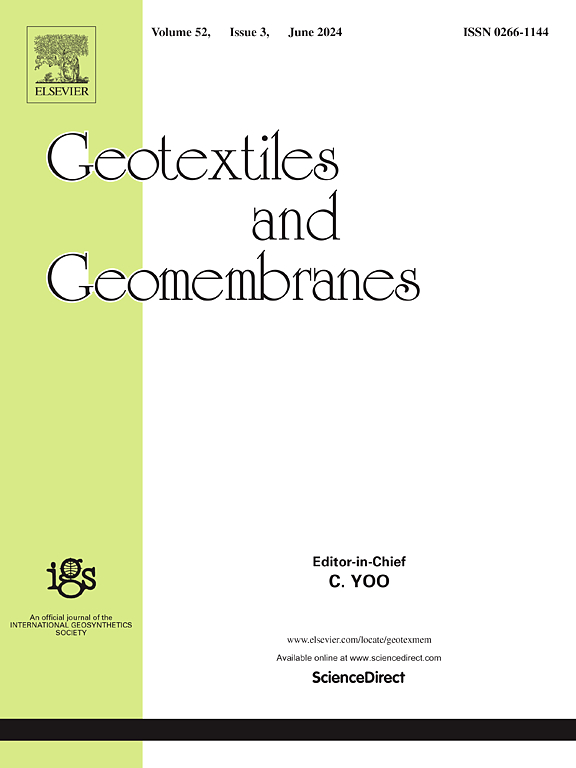Laboratory validation of seismic damage assessment in reinforced soil models based on sensor-enabled piezoelectric geogrids (SPGG)
IF 6.2
1区 工程技术
Q1 ENGINEERING, GEOLOGICAL
引用次数: 0
Abstract
Earthquakes are common geological disasters, and slopes under seismic loading can trigger coseismic landslides, while also becoming unstable due to accumulated damage caused by the seismic activity. Reinforced soil slopes are widely used as seismic-resistant geotechnical systems. However, traditional geosynthetics cannot sense internal damage in reinforced soil systems, and existing in-situ distributed monitoring technologies are not suitable for seismic conditions, thus limiting accurate post-earthquake stability assessments of slopes. This study presents, for the first time, the use of a batch molding process to fabricate self-sensing piezoelectric geogrids (SPGG) for distributed monitoring of soil behavior under seismic conditions. The SPGG's reinforcement and damage sensing abilities were verified through model experiments. Results show that SPGG significantly enhances soil seismic resistance and can detect soil failure locations through voltage distortions. Additionally, the tensile deformation of the reinforcement material can be quantified with sub-centimeter precision by tracking impedance changes, enabling high-precision distributed monitoring of reinforced soil under seismic conditions. Notably, when integrated with wireless transmission technology, the SPGG-based monitoring system offers a promising solution for real-time monitoring and early warning in road infrastructure, where rapid detection and response to seismic hazards are critical for mitigating catastrophic outcomes.
基于传感器压电土工格栅(SPGG)的加筋土模型震害评估实验室验证
地震是常见的地质灾害,地震荷载作用下的边坡会引发同震滑坡,同时也会因地震活动造成的累积破坏而变得不稳定。加筋土边坡是一种广泛应用的抗震岩土工程体系。然而,传统的土工合成材料无法感知加筋土体系的内部损伤,现有的原位分布式监测技术也不适合地震条件,从而限制了对边坡的准确震后稳定性评估。本研究首次提出了使用批量成型工艺制造自传感压电土工格栅(SPGG),用于地震条件下土壤行为的分布式监测。通过模型实验验证了SPGG的加固和损伤感知能力。结果表明,SPGG能显著提高土体的抗震性能,并能通过电压畸变检测土体的破坏位置。此外,通过对阻抗变化的跟踪,可实现对加筋材料拉伸变形的亚厘米级量化,实现对地震条件下加筋土的高精度分布式监测。值得注意的是,当与无线传输技术相结合时,基于spgg的监测系统为道路基础设施的实时监测和预警提供了一种很有前景的解决方案,在道路基础设施中,快速检测和响应地震灾害对于减轻灾难性后果至关重要。
本文章由计算机程序翻译,如有差异,请以英文原文为准。
求助全文
约1分钟内获得全文
求助全文
来源期刊

Geotextiles and Geomembranes
地学-地球科学综合
CiteScore
9.50
自引率
21.20%
发文量
111
审稿时长
59 days
期刊介绍:
The range of products and their applications has expanded rapidly over the last decade with geotextiles and geomembranes being specified world wide. This rapid growth is paralleled by a virtual explosion of technology. Current reference books and even manufacturers' sponsored publications tend to date very quickly and the need for a vehicle to bring together and discuss the growing body of technology now available has become evident.
Geotextiles and Geomembranes fills this need and provides a forum for the dissemination of information amongst research workers, designers, users and manufacturers. By providing a growing fund of information the journal increases general awareness, prompts further research and assists in the establishment of international codes and regulations.
 求助内容:
求助内容: 应助结果提醒方式:
应助结果提醒方式:


